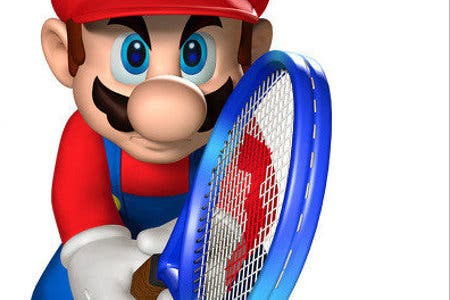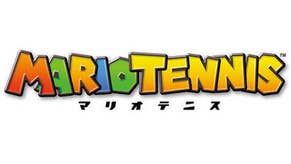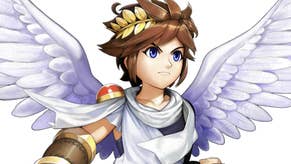Mario Tennis Open Review
Old balls.
I hope you weren't holding your breath. Save for the New Play Control Wii remix of GameCube's Mario Power Tennis in 2009, we've been left hanging on for a proper update to the series since 2005's Mario Tennis: Power Tour on Game Boy Advance. Quite why this solidly successful formula skipped the entirety of the DS generation has been something of a mystery - at least, it was until I'd spent several days thwacking my way across the courts of the series' 3DS debut.
Mario Tennis Open is as mechanically robust and colourfully compelling as you'd expect from Camelot, Nintendo's unfailingly reliable doubles partner. But where could it all go after GameCube? As undeniably enjoyable as 2012's take is, the studio still seems to be searching for a clear answer.
The game offers hyperactive arcade action over sober simulation, perfectly observing the fundamentals of the sport while sexing it all up (in Uncle Nintendo's wholesome way) with special moves that cause balls to explode away at ridiculous angles.
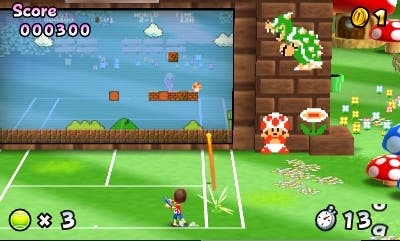
The key to mastering this instalment is in learning how to use Chance Areas. These circular zones appear across the court throughout each match; get to one before the ball arrives and you can unleash a special shot that's harder for your opponent to return. Each type of Chance Area is linked to a specific shot. Match the correct shot to the zone to perform it - or use the Normal Shot button, which works for everything with slightly diminished force.
In practice, Chance Areas both add to and occasionally subtract from the fun. Once you're familiar with the system, matches quickly become vicious, high-velocity power-struggles, with each player smashing more specials than a Street Fighter fireball-spammer. It's the sheer intensity that's appealing, the knowledge that you're only ever a pixel's width away from losing the point. Certainly, desperately clawing your way back from the brink, having been bludgeoned to the outer reaches of the game area, is enormously satisfying.
But while it's tempting initially to use every Chance Area, it pays to exploit them more strategically, suckering your opponent into thinking you're about to deploy a certain shot, then selecting a different one altogether. This flexible approach is far more effective and rewarding against human opponents, who are more susceptible to being hoodwinked and harried around against expectations than a computer.
The downside to Chance Areas is that they can also become all too predictable at times. Against AI - save for the very highest setting - I know with a large degree of confidence that successfully using a smash Chance Area will win the point. This creates, in effect, several redundant seconds during which you've already guessed the outcome.

Chance Area drop shots can exacerbate the problem. If the AI opponent returns the ball, it usually gives you a smash Chance Area, and the pattern repeats. Fortunately, the reverse does not apply. Frantic button-spamming can turn around a seemingly impossible situation, so it doesn't blight multiplayer.
There are three main game modes: Tournament, Exhibition (both single- and multiplayer) and the more gimmicky Special Games. The former offers eight cups to challenge for (16 if you count the doubles versions), the final four only playable using a character you've won the other lot with first.
Experienced players will find the default AI pretty tame for the most part, only really ramping up towards the end of the game. Even so, I won all eight cups in one sitting without losing a single match and using the first character I picked. And trust me, I'm no digital Djokovic.
Eventually you'll unlock Pro and Ace difficulties, and the latter does present a brutally uncompromising challenge against apparently psychic AI. Annoyingly, though, you can only adjust the difficulty in Exhibition, which is limited to single matches - thereby robbing you of any heroic, against-the-odds, trophy-winning moments in Tournament mode.
The back-of-the-hand familiar cast of Nintendo characters here is divided by ability as you'd expect, with fixed stats. If you want character progression, use a Mii.
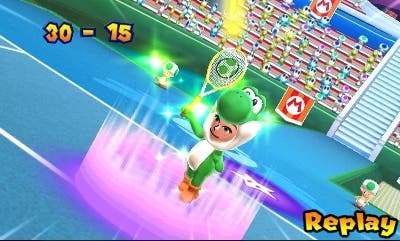
Costumes, rackets, boots and so on - unlocked via points you've collected - each offer subtly different performance changes to stuff such as the power of your shots, or your speed around the court. In truth, it largely feels peripheral to the game, with nothing that will dramatically affect the way you play.
It's an accessible game for absolute beginners, too. Hold the console up (with the feature enabled) and the view shifts low behind the player. Here, your character always moves to the correct spot unless instructed otherwise, and shots can be guided by tilting the console in the desired direction. Switchable, labelled panels on the touch screen mean you don't even have to worry about buttons.
Surprisingly for a game played from a fixed perspective, stereo 3D doesn't add a great deal to the Mario Tennis experience. Visually, it all runs attractively and smoothly either way, although you only really appreciate the depth on the very pretty Mario Galaxy-inspired stage, with its translucent court that reveals spinning globes and the inky blackness of space beneath.
There are also four mini-games. Ring Shot, lifted straight out of the series' GameCube entry, Ink Showdown and Galaxy Rally are boringly bland fare of the type we've seen many times before.
Thank goodness, then, for Super Mario Tennis, a delightfully executed sideshow in which you wallop the ball against a giant screen playing approximations of original Super Mario Bros. stages. Hitting coins, blocks and baddies extends your time, and Mushrooms and Fire Flowers power up your ball. It's still only an occasional distraction rather than anything you'll sink hours into, but at least it feels fresh and imaginative.
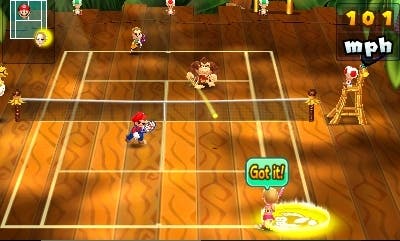
It is, as ever, in multiplayer that the latest incarnation of Mario Tennis excels. To its credit, Nintendo has enabled four-player local multiplayer via a single game cartridge. As for online, it's easy to set up a match with friends or a random knockabout against people in your region. Understandably, there's been little activity online prior to release, but I haven't experienced any performance issues in the games I've played.
Mario Tennis is terrific fun against a human opponent, as it's always been. A shame, then, that beyond offering a smooth gaming experience, the online portion is so thin, with not much else to pay attention to beyond your current score and position on a monthly leaderboard.
And that's Mario Tennis Open in a nutshell. The core is excellently put together, and as much fun as it's ever been against competitive mammals. But the content around it feels insubstantial, with little incentive to persist with single-player after the first few hours, unless you simply must obsessively collect everything like a deranged magpie.
What the game lacks in ambition and depth, though, it makes up for in the ageless pleasure and pain of a finely-balanced multiplayer battle. The ability to dip in and out for a quick, engaging match is a compelling proposition on a handheld. But after seven long years, it's a shame there aren't bigger ideas to rally around.
